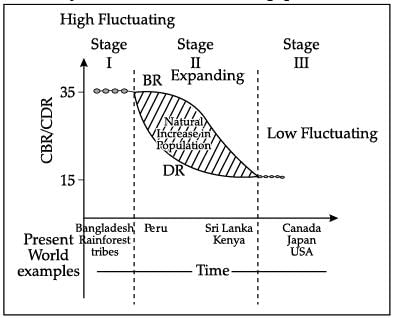Class 12 Exam > Class 12 Questions > Study the given graph carefully and answer th...
Start Learning for Free
Study the given graph carefully and answer the following questions:

From the given graph, what condition can you infer about the developing countries?
- a)High Birth Rate and High Death Rate
- b)Low Birth rate and Low Death rate
- c)High Birth Rate and Low Death Rate
- d)Low Birth Rate and High Death Rate
Correct answer is option 'C'. Can you explain this answer?
Most Upvoted Answer
Study the given graph carefully and answer the following questions:Fro...
The social structure, religious beliefs, economic prosperity and urbanisation within each country leads to high birth rates and low death rates in developing countries.

|
Explore Courses for Class 12 exam
|

|
Question Description
Study the given graph carefully and answer the following questions:From the given graph, what condition can you infer about the developing countries?a)High Birth Rate and High Death Rateb)Low Birth rate and Low Death ratec)High Birth Rate and Low Death Rated)Low Birth Rate and High Death RateCorrect answer is option 'C'. Can you explain this answer? for Class 12 2025 is part of Class 12 preparation. The Question and answers have been prepared according to the Class 12 exam syllabus. Information about Study the given graph carefully and answer the following questions:From the given graph, what condition can you infer about the developing countries?a)High Birth Rate and High Death Rateb)Low Birth rate and Low Death ratec)High Birth Rate and Low Death Rated)Low Birth Rate and High Death RateCorrect answer is option 'C'. Can you explain this answer? covers all topics & solutions for Class 12 2025 Exam. Find important definitions, questions, meanings, examples, exercises and tests below for Study the given graph carefully and answer the following questions:From the given graph, what condition can you infer about the developing countries?a)High Birth Rate and High Death Rateb)Low Birth rate and Low Death ratec)High Birth Rate and Low Death Rated)Low Birth Rate and High Death RateCorrect answer is option 'C'. Can you explain this answer?.
Study the given graph carefully and answer the following questions:From the given graph, what condition can you infer about the developing countries?a)High Birth Rate and High Death Rateb)Low Birth rate and Low Death ratec)High Birth Rate and Low Death Rated)Low Birth Rate and High Death RateCorrect answer is option 'C'. Can you explain this answer? for Class 12 2025 is part of Class 12 preparation. The Question and answers have been prepared according to the Class 12 exam syllabus. Information about Study the given graph carefully and answer the following questions:From the given graph, what condition can you infer about the developing countries?a)High Birth Rate and High Death Rateb)Low Birth rate and Low Death ratec)High Birth Rate and Low Death Rated)Low Birth Rate and High Death RateCorrect answer is option 'C'. Can you explain this answer? covers all topics & solutions for Class 12 2025 Exam. Find important definitions, questions, meanings, examples, exercises and tests below for Study the given graph carefully and answer the following questions:From the given graph, what condition can you infer about the developing countries?a)High Birth Rate and High Death Rateb)Low Birth rate and Low Death ratec)High Birth Rate and Low Death Rated)Low Birth Rate and High Death RateCorrect answer is option 'C'. Can you explain this answer?.
Solutions for Study the given graph carefully and answer the following questions:From the given graph, what condition can you infer about the developing countries?a)High Birth Rate and High Death Rateb)Low Birth rate and Low Death ratec)High Birth Rate and Low Death Rated)Low Birth Rate and High Death RateCorrect answer is option 'C'. Can you explain this answer? in English & in Hindi are available as part of our courses for Class 12.
Download more important topics, notes, lectures and mock test series for Class 12 Exam by signing up for free.
Here you can find the meaning of Study the given graph carefully and answer the following questions:From the given graph, what condition can you infer about the developing countries?a)High Birth Rate and High Death Rateb)Low Birth rate and Low Death ratec)High Birth Rate and Low Death Rated)Low Birth Rate and High Death RateCorrect answer is option 'C'. Can you explain this answer? defined & explained in the simplest way possible. Besides giving the explanation of
Study the given graph carefully and answer the following questions:From the given graph, what condition can you infer about the developing countries?a)High Birth Rate and High Death Rateb)Low Birth rate and Low Death ratec)High Birth Rate and Low Death Rated)Low Birth Rate and High Death RateCorrect answer is option 'C'. Can you explain this answer?, a detailed solution for Study the given graph carefully and answer the following questions:From the given graph, what condition can you infer about the developing countries?a)High Birth Rate and High Death Rateb)Low Birth rate and Low Death ratec)High Birth Rate and Low Death Rated)Low Birth Rate and High Death RateCorrect answer is option 'C'. Can you explain this answer? has been provided alongside types of Study the given graph carefully and answer the following questions:From the given graph, what condition can you infer about the developing countries?a)High Birth Rate and High Death Rateb)Low Birth rate and Low Death ratec)High Birth Rate and Low Death Rated)Low Birth Rate and High Death RateCorrect answer is option 'C'. Can you explain this answer? theory, EduRev gives you an
ample number of questions to practice Study the given graph carefully and answer the following questions:From the given graph, what condition can you infer about the developing countries?a)High Birth Rate and High Death Rateb)Low Birth rate and Low Death ratec)High Birth Rate and Low Death Rated)Low Birth Rate and High Death RateCorrect answer is option 'C'. Can you explain this answer? tests, examples and also practice Class 12 tests.

|
Explore Courses for Class 12 exam
|

|
Signup for Free!
Signup to see your scores go up within 7 days! Learn & Practice with 1000+ FREE Notes, Videos & Tests.


















